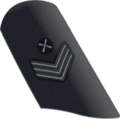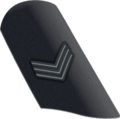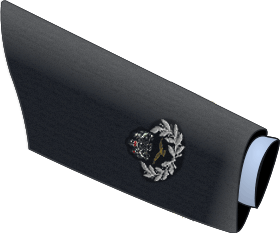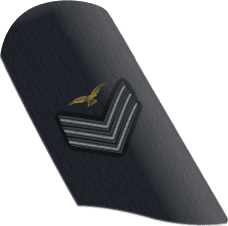RAF other ranks
 |
| Royal Air Force air component of the British Armed Forces |
|---|
| Components |
| History |
|
|
| Aircraft |
| Structure |
| Personnel |
The term used in the Royal Air Force (RAF) to refer to all ranks below commissioned officer level is other ranks (ORs). It includes warrant officers (WOs), non-commissioned officers (NCOs) and airmen.
Ranks
| NATO Code | OR-9 | OR-8 | OR-7 | OR-6 | OR-5 | OR-4 | OR-3 | OR-2 | OR-1 | |||||||||||||||||||
|---|---|---|---|---|---|---|---|---|---|---|---|---|---|---|---|---|---|---|---|---|---|---|---|---|---|---|---|---|
| (Edit) |
 |
No equivalent |  |
 |
 |
No equivalent |  |
 |
 |
 |
 |
No insignia | ||||||||||||||||
| Warrant officer | Flight sergeant | Chief technician | Sergeant | Corporal | Lance corporal RAF Regiment only |
Senior aircraftman/woman technician | Senior aircraftman/woman | Leading aircraftman/woman | Aircraftman/Woman | |||||||||||||||||||
| (Aircrew) (Edit) |
 |
No equivalent |  |
 |
No equivalent | No equivalent | No equivalent | No equivalent | No equivalent | |||||||||||||||||||
| Master aircrew | Flight sergeant aircrew | Sergeant aircrew | ||||||||||||||||||||||||||
| Abbreviation | WO/MAcr | FS | Chf Tech | Sgt | Cpl | LCpl | SAC Tech | SAC | LAC | AC | ||||||||||||||||||
Origins
Upon the formation of the Royal Air Force on 1 April 1918, rank titles and badges for ORs were adopted from the British Army, specifically the Royal Flying Corps (RFC). The RFC ranks of Flight Sergeant (equivalent to Staff Sergeant), Sergeant, Corporal and Air Mechanic were directly adopted. The RFC's four-bladed propeller trade classification badge above the Sergeants' and Flight Sergeants' chevrons was dropped.
To distinguish them from Army personnel, RAF personnel wore the RAF Eagle on a rectangular patch below the shoulder seam on the sleeve. The RAF Eagle is depicted with its beak turned to the rear rather than the front. RAF NCOs were fond of saying that represented that their eyes were everywhere.
The trade classification of Leading Aircraftman was created on 5th April 1918 to fill a void in the Service ranks. It was granted the double-bladed propeller rank insignia of the RFC Air Mechanic 1st Class and was equivalent in rank and authority to the Army appointment of Lance-Corporal. On 1 January 1919 the rank of Aircraftman replaced the ranks of Private, Air Mechanic, and Clerk. Aircraftmen were nicknamed "Erks" (a corruption of the word 'Aircraft') by the senior ranks, which was preferred to 'other ranks' or 'troops'.
The rank of Master Clerk was originally equivalent to Sergeant Major 1st Class. On 28 November 1918, the new rank of Chief Master Clerk was made equivalent to the rank of Sergeant Major 1st Class, and the old rank of Master Clerk was made equivalent to the rank of Sergeant Major 2nd Class.
| RAF other ranks (1 April 1918)[1] | RAF other ranks (1 January 1919)[2] | ||
|---|---|---|---|
| Technical | Administrative | Service | other ranks |
| Chief Master Mechanic | (Chief Master Clerk) | Sergeant Major 1st Class | Sergeant Major 1st Class |
| Master Mechanic | (Master Clerk) | Sergeant Major 2nd Class | Sergeant Major 2nd Class |
| Chief Mechanic | Flight Clerk | Flight Sergeant | Flight Sergeant |
| Sergeant Mechanic | Sergeant Clerk | Sergeant | Sergeant |
| Corporal Mechanic | Corporal Clerk | Corporal | Corporal |
| Air Mechanic 1st Class | Clerk 1st Class | (Leading Aircraftman) | Leading Aircraftman |
| Air Mechanic 2nd Class | Clerk 2nd Class | Private 1st Class | Aircraftman 1st Class |
| Air Mechanic 3rd Class | Clerk 3rd Class | Private 2nd Class | Aircraftman 2nd Class |
The original RAF ranks are vertically listed by seniority; the Technical ranks had precedence over the Administrative ranks, which in turn had precedence over the Service ranks. This was meant to keep non-technical NCOs from interfering with the efforts of technical and administrative NCOs. This was abolished in January 1919 and a streamlined single-column rank system was devised.
Changes in 1933 & 1939 — warrant officers
In 1933, the ranks of Sergeant Major 1st Class and Sergeant Major 2nd Class were renamed Warrant Officer Class I and Warrant Officer Class II to put them in line with the Army. In 1939, the rank of Warrant Officer II was abolished and the rank of Warrant Officer I was renamed Warrant Officer. RAF Warrant Officers were given equivalent status to the continuing Army rank of Warrant Officer Class I.
Changes in 1946 — aircrew
On 1 July 1946, NCOs serving as aircrew were assigned different rank badges which distinguished them from ORs in ground trades. The new ranks were:
| RAF aircrew ranks (1946-1950) | ||
|---|---|---|
| RAF aircrew rank | equivalent RAF rank | insignia of rank |
| Master Aircrew | Warrant Officer | Wreath closed by Royal Arms and inset with an RAF Eagle within. |
| Aircrew I | Flight Sergeant | Crown over Wreath closed by an RAF Eagle and inset with three 6-pointed stars within. |
| Aircrew II | Sergeant | Wreath closed by an RAF Eagle and inset with three 6-pointed stars within. |
| Aircrew III | Corporal | Wreath closed by an RAF Eagle and inset with two 6-pointed stars within. |
| Aircrew IV | Leading Aircraftman | Wreath closed by an RAF Eagle and inset with one 6-pointed star within. |
| Aircrew Cadet | Trainee | Wreath closed by an RAF Eagle and a blank field within. |
The RAF Eagle in the insignia is properly displayed with its beak turned to the rear.
Changes in 1950 — technicians & aircrew
In 1950, a new grading system for technicians was introduced. This involved the creation of the following ranks:
- Master Technician (for Warrant Officers in technical trades)
- Chief Technician (for Flight Sergeants in technical trades) with three inverted chevrons surmounted by a crown
- Senior Technician (for Sergeants in technical trades) with three inverted chevrons
- Corporal Technician (for Corporals in technical trades) with two inverted chevrons
- Junior Technician with one inverted chevron
Also in 1950, the unpopular NCO aircrew ranks were abolished, although Master Aircrew was retained as a rank. Aircrew I became Flight Sergeant Aircrew and Aircrew II, III and IV became Sergeant Aircrew. Both new ranks adopted a gold RAF Eagle between the chevrons to permit continuing distinction from ground trades. Aircrew cadets wore the RAF Eagle on its own as a trade classification badge.
 |  |  |
 |  |  |
| Master Aircrew | Flight Sergeant Aircrew | Sergeant Aircrew |
Changes in 1951 — junior ranks
On 1 January 1951, two junior ranks were introduced:
- Senior Aircraftman/Senior Aircraftwoman with a triple-bladed propeller.
- Leading Aircraftman/Leading Aircraftwoman with a double-bladed propeller (this had previously been only a trade classification and not a rank)
Changes in 1964 — technicians
In 1964, the technician ranks were abolished, with the exception of Junior Technician and Chief Technician, the latter becoming an intermediate rank between Sergeant and Flight Sergeant for Technical Trades. Junior Technicians adopted the four-bladed propeller as their badge of rank and Chief Technicians adopted a treble chevron surmounted by a four-bladed propeller as their rank insignia. Master Technicians, Senior Technicians and Corporal Technicians became Warrant Officer, Sergeant and Corporal respectively. The ORs structure became:
- Warrant Officer (WO) / Master Aircrew (MAcr)
- Flight Sergeant (Flt Sgt, F/Sgt, or FS) / Flight Sergeant Aircrew (FSAcr)
- Chief Technician (Chf Tech, C/T, or CT)
- Sergeant (Sgt) / Sergeant Aircrew (SAcr)
- Corporal (Cpl)
- Junior Technician (Jnr Tech, J/T, or JT)
- Senior Aircraftman (SAC) / Senior Aircraftwoman (SACW)
- Leading Aircraftman (LAC) / Leading Aircraftwoman (LACW)
- Aircraftman (AC) / Aircraftwoman (ACW)
Changes in 2005 — phasing out of Junior Technician
From 2005 onwards, no more airmen have been promoted to Junior Technician. Although there are currently personnel in the rank of Junior Technician, once they have all been promoted or discharged from the RAF, the rank will cease to be used. From March 2005, SACs in technical trades who had attained the Operational Performance Standard were promoted to Senior Aircraftman/Aircraftwoman (Technician) SAC(T) and given a new badge of rank, consisting of the three-bladed propeller inside a circle. This new rank was introduced, to distinguish airmen trained to work unsupervised from those who were not, and is equivalent to the old Junior Technician rank.
Changes in 2010 — introduction of Lance Corporal
On 1 April 2010, the RAF Regiment introduced the rank of Lance Corporal for current SACs who undertake the role of section second-in-command/fire team commander. This gives them more authority on the ground, as well as a better pay band. It seems that the rank will not be moving to other trades, and will be solely in the RAF Regiment.[3]
See also
- Aircrew brevet
- British Army Other Ranks rank insignia
- Comparative military ranks of World War I
- Comparative military ranks of World War II
- Comparative military ranks
- List of Royal Air Force members
- Military rank
- Ranks and insignia of NATO Air Forces Enlisted
- Royal Navy ratings rank insignia
Footnotes
- ↑ Air Ministry Weekly Order 109 (1921, reprint of 1923)
- ↑ Air Ministry Weekly Order 109 (1921, reprint of 1923)
- ↑ Lesley Woods, ed. (12 April 2010). "New Rank for the RAF Regiment". Royal Air Force website. www.RAF.mod.uk. Retrieved 16 March 2016.